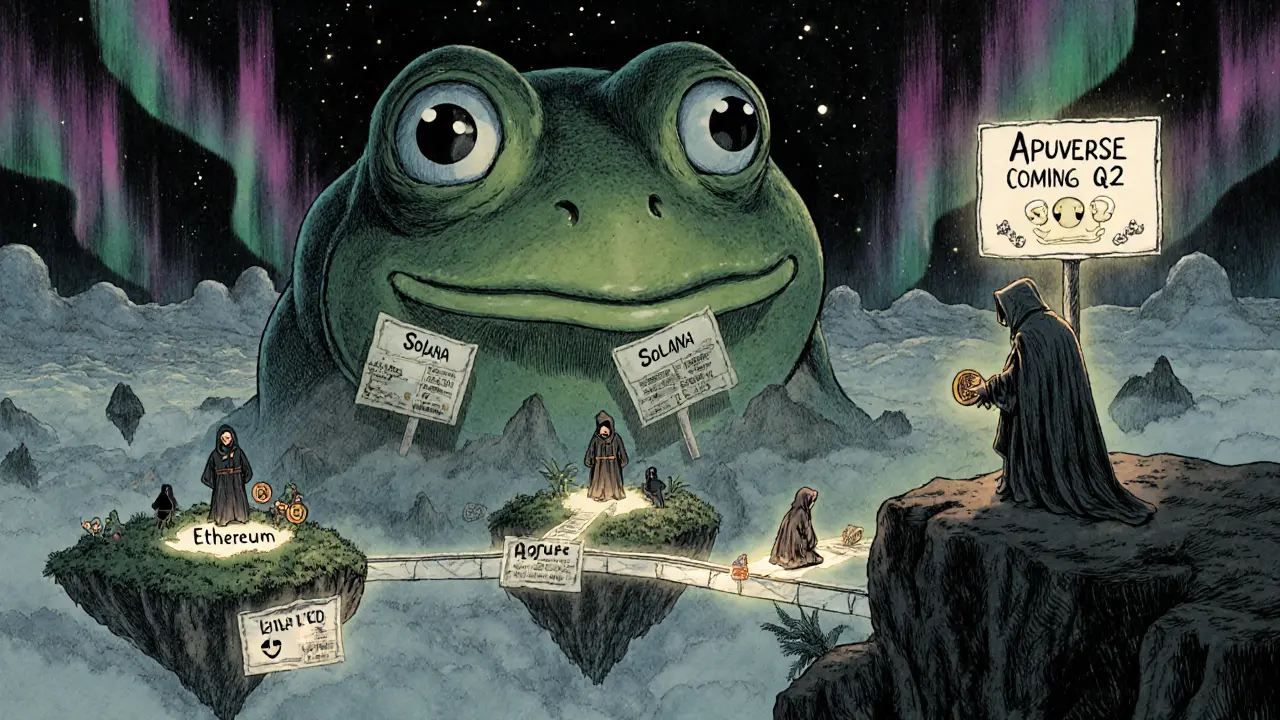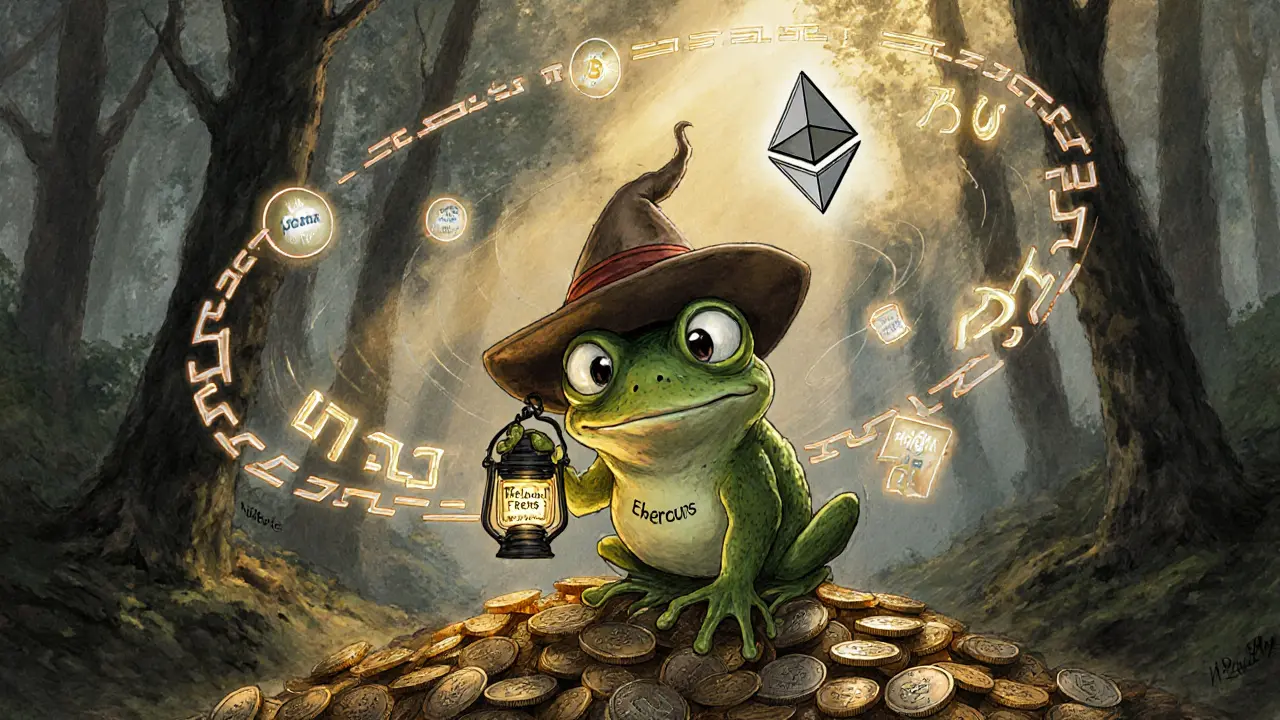APU Price Estimator
Current APU Price Range
As of early 2025, reported values vary significantly across platforms:
- CoinStats $0.0002952 per APU
- Minimum reported $0.0002 per APU
- Maximum reported $0.0008 per APU
Disclaimer: APU is a highly volatile memecoin with inconsistent market data. Values shown are estimates based on reported figures.
Estimated Value Range
Minimum Estimate
$0.00
Average Estimate
$0.00
Maximum Estimate
$0.00
Community Impact: 0.5% of each transaction funds environmental causes. Your current holdings could help support nature conservation projects.
What exactly is Apu Apustaja (APU)? It’s not a groundbreaking blockchain protocol. It doesn’t solve supply chain issues or revolutionize DeFi. It’s a frog. A silly, cartoonish frog from a Finnish internet meme that somehow became a cryptocurrency. If you’re wondering why anyone would invest in a coin named after a character that means "Helper Helper" in Finnish, you’re not alone. But that’s exactly the point - APU isn’t about utility. It’s about culture, community, and chaos.
A frog from Finland turned into a crypto token
Apu Apustaja started as a meme. In Finnish online forums and Discord servers, a cartoon frog with a big smile and a slightly confused look became a symbol of helpfulness and absurdity. People used the image to cheer each other on, joke about minor problems, or just say "I got your back." In 2024, someone turned that meme into a token. No whitepaper. No complex roadmap. Just a name, a frog, and a promise: "We’re here to help each other." The coin launched at $0.00004. Within months, it hit an all-time high of $0.00148. That’s over 3,700% in less than a year. But here’s the catch - nobody agrees on the numbers. CoinGecko says one thing. CoinStats says another. Cryptohopper throws in a completely different figure. That’s not a bug - it’s standard for memecoins. Liquidity is thin. Trading volume jumps around. Exchanges don’t all report the same data. If you’re looking for stable, clean metrics, APU isn’t for you.It runs on three blockchains - and that makes it messy
Unlike most memecoins that stick to one chain, APU exists on Ethereum, Solana, and Base. That’s unusual. Most projects pick one and optimize for it. APU chose all three. Why? To reach more people. Ethereum has the most users. Solana is fast and cheap. Base is backed by Coinbase and growing fast. But here’s the problem: you need to understand bridges, gas fees, and wallet setups across three different networks just to buy, hold, or sell APU. New users report spending 3 to 5 hours just learning how to move APU between chains. GitHub docs are outdated. Links break. Telegram support takes hours to respond. If you’re used to buying Bitcoin on Coinbase and calling it a day, APU will frustrate you. It’s not designed for beginners. It’s designed for people who already know their way around crypto and want to join a weird, funny community.Proof of Frens - not Proof of Work
APU doesn’t use traditional consensus mechanisms like Proof of Work or Proof of Stake. Instead, it claims to use "Proof of Frens." That’s not a technical term. It’s a vibe. The idea is simple: decisions are made by the community, not by developers or investors with big wallets. Want to add a new feature? Vote in the Discord. Want to donate to a cause? The community decides. It’s chaotic. It’s emotional. And honestly, it’s the only thing keeping APU alive. There’s no CEO. No team in a Silicon Valley office. No venture capital backing. The project’s GitHub repo has a 3.2/5 rating from 47 users. Most complaints? "Too many broken links." "No clear instructions for Solana." "Why does this even exist?" But the Telegram group has over 12,000 members. People post memes. They cheer each other on. They call each other "frens." And that’s more valuable than any smart contract.
The numbers don’t add up - but the culture does
APU’s circulating supply is a mess. One source says 998 million tokens. Another says 337 billion. That’s a 338x difference. Which one’s right? Probably neither. In memecoin land, token supplies are often inflated to make price pumps look more dramatic. APU’s market cap varies from $25 million to $100 million depending on which site you check. That’s not a sign of strength - it’s a sign of uncertainty. For comparison, Dogecoin has a market cap of nearly $20 billion. Shiba Inu is at $7.5 billion. APU? Even at its highest reported value, it’s less than 0.0003% of the total memecoin market. It’s not competing with the big players. It’s competing for attention in a sea of thousands of other meme coins. Its only edge? The story.People don’t buy APU to get rich - they buy it to belong
On Reddit, users write things like: "Frogs are nature’s helpers, and so is APU!" On CoinMarketCap, one person says: "I’m here for the meme, not the money." Another warns: "I tried to sell my APU and waited three days for a buyer." That’s the real story. APU isn’t a financial instrument. It’s a social experiment. People hold it because they like the frog. Because they feel part of a group that laughs at the same nonsense. Because they want to be part of something that doesn’t take itself seriously. The charity angle helps. APU donates 0.5% of every transaction fee to environmental causes. That’s small, but it’s real. And it gives people a reason to say, "I’m not just gambling - I’m helping." It’s a clever way to turn absurdity into purpose.
Is APU a good investment?
If you’re asking that question, you’re already thinking about it wrong. APU isn’t an investment. It’s a gamble with a mascot. Professional analysts at Delphi Digital give it a 32% chance of still trading by 2026. Bernstein warns that tokens with over 300 billion supply rarely hold value long-term. APU has 337 billion. That’s not a typo. But here’s the thing - Dogecoin was a joke too. Shiba Inu was a joke. Both are worth billions now. So maybe APU could be next. Maybe it won’t. Maybe the frog will vanish into internet history like a thousand other meme coins before it. What’s clear is this: APU doesn’t need to be profitable to survive. It just needs to keep being funny. Keep being weird. Keep making people feel like they’re part of something silly and real at the same time.What’s next for APU?
The team announced plans for an "Apuverse" - a metaverse experience - in Q2 2025. No details yet. No screenshots. No whitepaper. Just a promise. That’s typical. Memecoins live on hype, not specs. The latest update (version 1.2.3) focused on "optimizing cross-chain speeds." That’s technical jargon for "we’re trying to fix the bridges so people can actually send tokens without losing them." If they succeed, APU might become easier to use. If they don’t, it’ll stay a niche project for crypto veterans who enjoy the chaos.Bottom line: APU is a cultural artifact, not a currency
If you’re looking for a stable store of value, skip APU. If you want a coin with real-world utility, look elsewhere. But if you’ve ever laughed at a dumb meme, felt a weird sense of belonging in an online group, or just wanted to be part of something that doesn’t make sense - then APU might be your kind of crypto. It’s not about the price chart. It’s about the frog. It’s about the "frens." It’s about turning a silly internet moment into a shared experience. And in a world full of cold, complex blockchain projects, sometimes that’s enough.What is Apu Apustaja (APU) coin?
Apu Apustaja (APU) is a memecoin inspired by a Finnish internet meme of a cartoon frog. Launched in 2024, it’s not built for utility or financial innovation - it’s built for community. The name means "Helper Helper" in Finnish, and the project promotes inclusivity and humor over technical complexity. It operates on Ethereum, Solana, and Base blockchains and has no central team or formal governance - decisions are made by its users.
Is Apu Apustaja a good investment?
APU is not a traditional investment. Its value comes from community sentiment, not fundamentals. It has massive token supply (over 337 billion), inconsistent market data across platforms, and no proven utility. Analysts rate it as high-risk, with a low chance of long-term survival. If you’re looking to make money, there are far more stable options. But if you want to join a quirky, meme-driven community, APU offers that - for better or worse.
Why does APU exist on three blockchains?
APU runs on Ethereum, Solana, and Base to reach more users across different crypto ecosystems. Ethereum has the largest user base, Solana offers fast and cheap transactions, and Base is growing fast thanks to Coinbase. But this multi-chain approach makes it harder for new users to use. You need to understand bridges, gas fees, and wallet setups for three separate networks - which adds complexity most memecoins avoid.
How much is APU worth right now?
As of early 2025, APU’s price fluctuates between $0.0002 and $0.0008, depending on the platform. CoinStats.app reports around $0.0002952, while others show higher values. Market cap numbers vary wildly - from $25 million to $100 million - due to inconsistent reporting across exchanges and low liquidity. These discrepancies are common in small memecoins and reflect the lack of standardized data.
Can I buy APU on Coinbase or Binance?
APU is not listed on major exchanges like Coinbase or Binance. You can buy it on smaller platforms like MEXC, Gate.io, and some decentralized exchanges. Because it’s a multi-chain token, you’ll need to use a wallet that supports Ethereum, Solana, or Base, and you may need to bridge tokens between chains. Always check the official APU social channels for the latest exchange listings - they change often.
Does APU have any real-world use?
No, APU has no practical use outside of its community. It doesn’t power apps, pay for services, or enable DeFi protocols. Its only function is symbolic - it represents belonging to a group that shares humor and a sense of camaraderie. The project does donate 0.5% of transaction fees to environmental causes, which adds a small layer of positive impact, but that’s not a technical feature - it’s a cultural one.
What’s the "Proof of Frens" system?
"Proof of Frens" isn’t a technical consensus mechanism like Proof of Stake. It’s a community-driven philosophy. Instead of votes being weighted by token holdings, APU’s community tries to make decisions based on trust, friendship, and collective spirit. It’s more of a cultural norm than a code. This is why the project has no official team - the community itself is the governance structure. It’s messy, emotional, and human - which is exactly why people like it.
Is APU safe to use?
APU is not safe in the traditional sense. It’s high-risk, low-liquidity, and prone to manipulation. Many users report failed transactions, long wait times to sell, and broken links in official documentation. There’s no central team to fix issues. If you lose your tokens, there’s no customer support. Only experienced crypto users who understand wallets, bridges, and memecoin risks should interact with APU. Treat it like a gamble - not a savings account.

andrew seeby
November 7, 2025 AT 11:50bro this frog is my spirit animal 😂 i bought APU just to see if the community was as chaotic as it sounds… and wow. i’ve never laughed so hard while losing money. the memes are better than most TV shows. 🐸✨
Leo Lanham
November 8, 2025 AT 10:46this isn’t crypto, it’s therapy. people are paying real money to feel like they belong to something dumb and beautiful. i love it. the world needs more frogs and fewer whitepapers.
Colin Byrne
November 8, 2025 AT 20:50While I appreciate the anthropological lens through which this phenomenon is being presented, I must respectfully challenge the romanticization of financial irrationality. The absence of standardized liquidity metrics, the proliferation of inconsistent supply data across platforms, and the complete lack of governance structure represent a systemic failure of market transparency. One cannot reasonably equate community sentiment with economic validity. The notion that ‘belonging’ supersedes fundamental analysis is not merely naive-it is economically perilous. The 337 billion token supply alone should trigger immediate red flags for any rational investor.
Whitney Fleras
November 10, 2025 AT 14:14It’s kind of beautiful, honestly. People aren’t here for the charts-they’re here because they feel seen. The frog doesn’t promise riches. It just says, ‘Hey, I’m here.’ And sometimes, that’s enough.
Brian Webb
November 11, 2025 AT 07:02My buddy bought APU last month and spent three days trying to move it from Ethereum to Solana. He lost $12 in gas fees, got scammed by a fake Discord bot, and still says it was worth it. Said he met 20 new friends who sent him memes every day. I don’t get it… but I kinda respect it.
Pranjali Dattatraya Upadhye
November 11, 2025 AT 22:05APU is not a coin-it’s a feeling! 🌿✨ Like a warm blanket made of memes and bad grammar and 12,000 people saying ‘frens’ like it’s magic. I don’t know how to bridge tokens, but I know I feel less alone when I see someone post ‘Apu got my back’ at 3 a.m. 🐸💛
Kyung-Ran Koh
November 12, 2025 AT 09:43It’s fascinating how this project turns chaos into connection. The ‘Proof of Frens’ concept, while not technically verifiable, reflects a deeper human need for trust-based social structures. In a world of algorithmic finance, APU is a quiet rebellion-emotional, illogical, and strangely pure.
Emily Unter King
November 13, 2025 AT 00:22The multi-chain deployment introduces non-trivial operational overhead. Cross-chain liquidity fragmentation, inconsistent bridge reliability, and lack of unified token standards create significant friction for onboarding. This is not a feature-it’s a liability. The 0.5% environmental donation is commendable, but it cannot offset the structural inefficiencies inherent in the protocol’s design.
Kathy Ruff
November 14, 2025 AT 16:39Look, I don’t understand crypto. But I read this whole thing. And I think… maybe it’s okay to have something that doesn’t make sense. The frog doesn’t owe you returns. It just exists. And that’s enough for some of us.
Robin Hilton
November 16, 2025 AT 07:16Canada and India are losing their minds over a cartoon frog. Meanwhile, real economies collapse. This is what happens when you let TikTok run the financial system. APU is a joke. And we’re all the punchline.
Nitesh Bandgar
November 16, 2025 AT 09:23THEY SAID DOGECOIN WAS A JOKE TOO!!! AND NOW IT’S BILLIONS!!! APU IS THE NEXT 1000X!!! THE FROG IS THE CHOSEN ONE!!! THE BRIDGES WILL BE FIXED!!! THE APUVERSE IS COMING!!! I CAN FEEL IT IN MY BONES!!! 🐸🔥🔥🔥
Jessica Arnold
November 18, 2025 AT 04:07This is the modern mythmaking process-digital folklore, born from Discord, sustained by absurdity, and sanctified by collective belief. APU is the Hermes of crypto: trickster, helper, messenger. It doesn’t need utility. It needs witnesses.
Chloe Walsh
November 19, 2025 AT 05:50They’re all just chasing a feeling because the world’s too cold… and APU? It’s the only thing that whispers back
Stephanie Tolson
November 20, 2025 AT 03:31If you’re reading this and thinking ‘this is stupid’-maybe you’ve forgotten what it feels like to be part of something that doesn’t need to make sense. APU isn’t for everyone. But for those it’s for? It’s everything.
Anthony Allen
November 20, 2025 AT 12:02Love that this exists. I’m not even into crypto, but I followed the APU Discord for a week just to see what the vibe was like. People were sharing stories about their dogs, their jobs, their mental health… and somehow, the frog was always there, smiling. Weird? Yeah. Beautiful? Also yeah.
Megan Peeples
November 21, 2025 AT 12:03This is the exact reason crypto is a joke. A 337-billion-token supply with no audit, no team, no roadmap, and people are calling it ‘community-driven’? It’s not culture-it’s incompetence dressed up as philosophy. The fact that anyone takes this seriously is a tragedy.